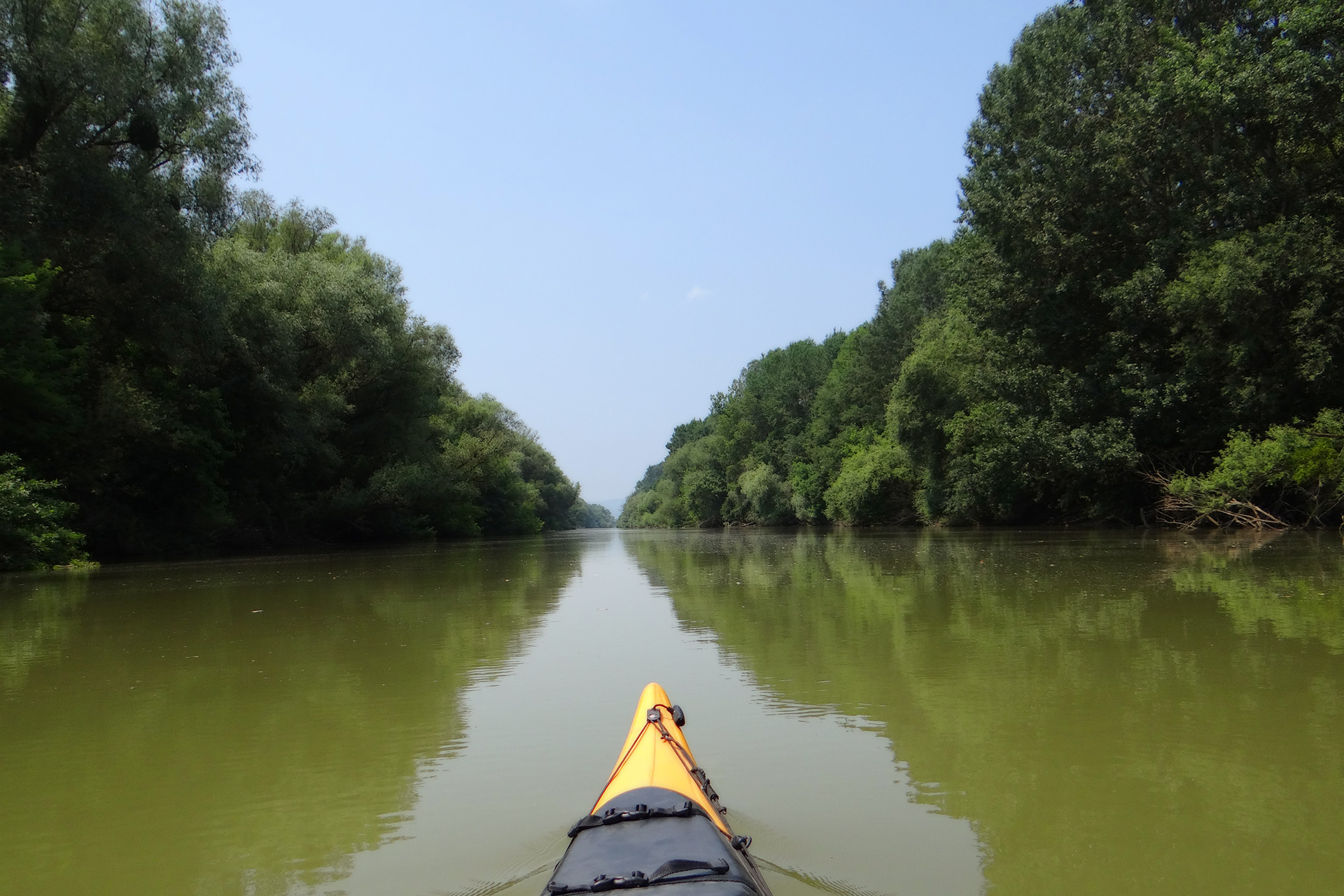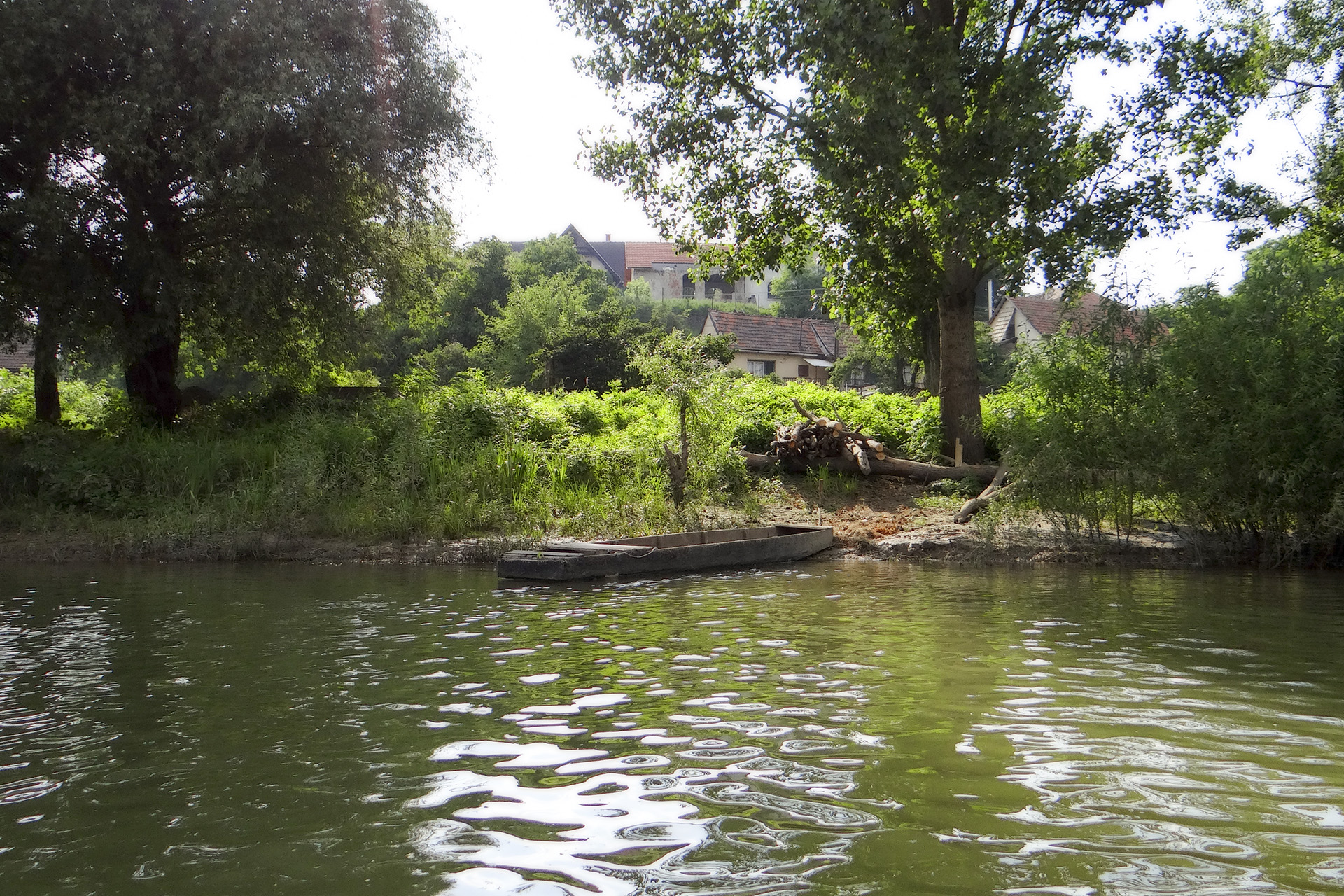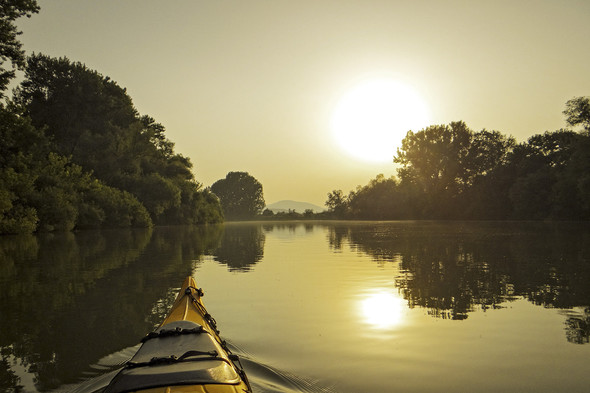We are continuing our Wine Paddling series, which we began last year. This time we are going to visit the world’s oldest appellation, the Tokaj Wine Region, known as Hegyalja by the locals. Before flow controls were introduced in the 19th century, the river Bodrog meandered through the region at twice its current length, before entering the river Tisza in the town of Tokaj. If you look at the Google Earth satellite image today, the remains of its ancient bends and many oxbow lakes are still visible. On our three-day adventure, we paddled down from the village of Zemplín in Slovakia to the Hungarian town of Tokaj.
We split the total distance (65 kilometres) into three parts to make sure of some extra time for wine-tasting and winery visits in addition to paddling. How different this situation would have been 150 years ago! At that time, we would have travelled 112 kilometres, most likely losing our way without a local guide among the countless bends and islands, the river swelling into a unique giant lake known as Bodrogköz during spring floods. Nowadays, the river still does not flow very fast, and on the lower section, you may even feel as if you are rowing upstream due to the effect of the backward swell of the Tisza.

The river Bodrog – although in the summer, many tourists can be found on the water - is not a particularly popular area for paddling, so if you want to test your skills with the oars here, you have to be prepared for a genuine wild romance and a lack of infrastructure. There aren’t any established moorings and there is barely a campsite around. In most of the waterfront villages, we have to walk some ways in search of a shop and it’s not necessarily a good idea to leave your boat unattended on the shore. The start of our tour, the village of Zemplín, despite having been a county town at the time of the old Hungarian Kingdom, is now a dusty little settlement. At that time, it had a strong castle, surrounded by the river on three sides, while on the fourth there were ramparts and a moat system. Nowadays you can’t even see the castle ruins, as the village’s two churches were built in its place. It’s worth putting in at the now non-existent harbour, but be aware that after flooding, the whole area becomes boggy, making launching back onto the water nigh on impossible. We paddled 20 kilometres downstream on our first day, through the settlements of Ladmovce, Viničky and Borša. Viničky is already within the historical wine region of Tokaj. The peace treaty ending the First World War decided that it would become part of Slovakia, together with two other settlements in the wine region. We paddle across the border of the country without noticing; just a ferry for foot passengers appearing after a left bend and a riverside beach on the left bank signal that we have arrived at our day’s destination, Felsőberecki, already in Hungary.
Sights on the way: The wineries and cellars of Vinicky, and the castle in Borsa, the birthplace of Ferenc Rákóczi II.
Accommodation: Bodrog Hostels and Campsite in Felsőberecki
Recommended event: Wine-tasting at the Zlaty Strapec winery
A few words about the history of the wine region. There is definite evidence of the existence of advanced developed viticulture in this area in the 9th century, which was then continued by the conquering Hungarians (Magyars). Aszú, a unique natural sweet wine, for which the name of Tokaj is famous all over the world, was most likely born some time during the 15th to 16th centuries. If we want to simplify things, we can say that there were three basic wine styles in existence in the region: a dry wine, a type of sweet wine where the aszú berries were not selected (originally, it was called ‘Main Wine’, later Szamorodni) and finally the extremely concentrated, high in sugar Aszú. The world’s first classification of vineyards was made here in 1730 and the first controlled wine appellation in the world was born in 1737.
Later, phylloxera and the peace treaty ending the First World War set back the Tokaj wine region for many years and was then aggravated by the Communist takeover in 1947. One of the world’s most famous wines had gone into a deep sleep, during which time, abusing the name of Tokaj, unworthy wines were produced for the eternally thirsty Soviet market. The change of the political regime and the 90s brought a turnaround. Domestic and foreign investors appeared once again, and traditions were revived. The highly oxidative style, which had unfortunately personified Tokaj Aszú for two generations, faded into the background, and a new style was born - in fact no other than the method used to produced Aszú a hundred years ago. Another unfortunate practice was the fortification of Aszú. This first came about by a law passed in 1924 which allowed producers to do so in order prevent their wines from being spoilt due to the post-war market loss. Unfortunately, this case set a precedent, and producers often fortified some of their wine right up until the end of the 80s, that wine which is the most famous, natural sweet wine in the world! Those who visit Hegyalja today find themselves right into the centre of changes. It is not necessarily an advantage, but it is exciting. On the Slovakian side, the laws are more permissive and regulations are different to those on the Hungarian side. In Slovakia, there are 3, 4, 5 and 6 puttonyos Aszú (vyber in Slovakian) and producers often still make Aszú in the ‘old’ traditional oxidative style that had emerged during the Communist era. But, make no mistake about it, there is no such thing as a reductive Aszú! Barrel ageing is also obligatory on the Hungarian side, but here the ageing is shorter or more sulphur is added to the wine, but they most certainly don’t keep it in smaller quantities in order to achieve a fast, violent oxidation. Legislation in Hungary has changed in recent years and is still in a state of flux. What is certain is that the 3 and 4 puttonyos Aszú will disappear from the shelves and what’s more, it’s conceivable that in future only the name Aszú will be stated on the label, with the proviso that the former 5 puttonyos is the minimum requirement. On the Slovakian side, much less emphasis is placed on dry wines compared to the Hungarian side, where the old vineyard classification has been revived over the past decade; dry wines can interpret this best. Among the hundreds of vineyards, the most well-known ones already provide a serious plus for the Hungarian and sometimes also for the foreign consumer. It seems that not only Aszú can take its rightful place on the global market, dry Furmint is slowly also becoming worthy of this position.

The next morning, it’s worth setting off early, as we would like to reach the town of Sárospatak before the extreme heat kicks in. A good place to moor is on the left bank, just before the bridge, at the Reformed Church’s boathouse. From here, it is just a short walk to the centre to have a look around. The castle is a must-see, but the thermal spa is also well worth a detour! In the afternoon, we reach Olaszliszka in just a few hours of paddling and a sharp left bend. You can see its characteristic church tower from far away!
Sights on the way: The castle and thermal bath of Sárospatak, and the church in Olaszliszka
Recommended activities: Travelling to the vineyards of Olaszliszka by horse and carriage with the Amici Vinorum wine fans group, and wine-tasting at the winery of Samuel Tinon
Accommodation: Komp Guesthouse and campsite in Olaszliszka
On the last day we don’t have far to travel; nevertheless, there is a strong backwater pull on the Bodrog by the Tisza, so we make slower headway. It’s worth setting off early so that you can have lunch at the Lebuj restaurant, from where Château Dereszla winery in the “Lebuj” bend of Bodrogkeresztúr is just a minute’s walk away! (The winery’s 2007 5 puttonyos Aszú made 20th place on the Wine Spectator’s TOP100 in 2013!). An important rule is that wine tasting should be just that, tasting, as paddling drunk is not only dangerous, but the police taking fining any wrongdoers seriously! From here, the river already winds around the Tokaj Kopasz Hill until finally on the right bank, the houses and steeples of Tokaj, which gives its name to the wine region, come into view. The Tisza arrives on the left-hand side, above the bridge, but make sure you paddle carefully here, as there are often crazy speedboat drivers racing along the river. It’s best to tie up on the right (not on the town side), turning left before you reach the bridge and paddling100 metres back up the river Tisza, as the campsite has its own jetty. You can stay there for the night, but if you are fed up with nomadic life, you can just tie up your boat and then walk into Tokaj across the bridge, where you can choose from more comfortable lodgings.
Sights on the way: The town of Tokaj, a UNESCO World Heritage Site
Accommodation: Tiszavirág campsite or Paulay Wine House (Borház)
Recommended activity: Wine-tasting at the Château Dereszla Winery , or the Paulay Wine House






